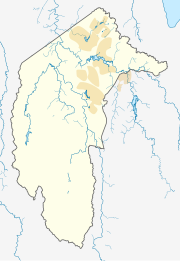Chisholm, Australian Capital Territory
| Chisholm Canberra, Australian Capital Territory | |||||||||||||||
|---|---|---|---|---|---|---|---|---|---|---|---|---|---|---|---|
 View of Chisholm from Macarthur Hill | |||||||||||||||
 Chisholm | |||||||||||||||
| Coordinates | 35°25′27″S 149°7′21″E / 35.42417°S 149.12250°ECoordinates: 35°25′27″S 149°7′21″E / 35.42417°S 149.12250°E | ||||||||||||||
| Population | 5,121 (2016 census)[1] | ||||||||||||||
| • Density | 1,652/km2 (4,280/sq mi) | ||||||||||||||
| Established | 1982 | ||||||||||||||
| Gazetted | 5 August 1975 | ||||||||||||||
| Postcode(s) | 2905 | ||||||||||||||
| Area | 3.1 km2 (1.2 sq mi) | ||||||||||||||
| District | Tuggeranong | ||||||||||||||
| Territory electorate(s) | Brindabella | ||||||||||||||
| Federal division(s) | Bean | ||||||||||||||
| |||||||||||||||
Chisholm (/ˈtʃɪzəm/) is a suburb in the Canberra, Australia district of Tuggeranong, named after Caroline Chisholm.[2]
It was gazetted on 5 August 1975, and streets are named after notable women.[2]
It is nearby suburbs of Gilmore, Fadden, and Richardson. It is bounded by , and the Monaro Highway. Chisholm and Gilmore are separated by Simpsons Hill, which provides some wilderness with walking tracks over it, popular for walking dogs.
Demographics[]
At the 2016 census, Chisholm had a population of 5,121 people. The median age of people in Chisholm was 36 years, compared to a median age of 35 for Canberra. Unemployment in Chisholm was half a percent lower than the Canberra average (2011). The median weekly personal income for people aged 15 years and over in Chisholm in 2016 was $919, compared to the ACT median of $998, while the median weekly household income was $2,028. In 2016, the median monthly housing loan repayment in Chisholm was $2,000.[1]
Aboriginal and Torres Strait Islander people made up 2.2% of the population 79.4% of all residents were born in Australia. The three main countries of birth for those born overseas were England, 3.0%, New Zealand, 1.3%, and India, 1.1%. 84.9% of people spoke only English at home The most popular religious affiliations in descending order are no religion 31.7%, Catholic 28.0%, Anglican 3.7%, Not stated 8.3% and Presbyterian and Reformed 2.5%.[1]
Suburb amenities[]
Chisholm Group Centre[]
The Chisholm Group Centre is located on Halley Street and Benham Street and has a variety of shops and service outlets. These include a Coles supermarket, tavern, restaurants, general practitioner, dentist, BP service station, Fire Station, Rugby union club, child care and several other businesses. Chisholm also has several sporting facilities: the Chisholm District Playing Fields located on Proctor Street, the Chisholm Neighbourhood Oval on Alston Street and The Pines Tennis Club on Norris Street.
Education[]

Caroline Chisholm School caters for students from Pre school to Year 10. Chisholm High School, now the Senior Campus opened in 1985; the school won the RAIA Canberra Medallion for Outstanding Architecture the following year. The senior campus caters for students in Years 7 to 10. Chisholm Primary School, now the Junior Campus caters for students in Preschool to Year 6. Both schools are located on Hambidge Crescent.[3]
The former is also located in Chisholm. This was a one teacher school which operated between 1870 and 1939. The surviving school building dates from 1880, and is now used as a museum.[4]
Transport[]
Chisholm is serviced by several ACTION bus routes. Routes 74 and 75 combine as a circular bus route which connects Chisholm and surrounding suburbs with the Tuggeranong Town Centre and Erindale Centre.[5] Route 182 runs during peak hour from the Lanyon Marketplace to City West via Barton and follows the Monaro Highway.[6] Routes 76 and 78 services surrounding suburbs including Gilmore and Richardson to Tuggeranong Interchange[7][8]
Politics[]
| |||||||||||||||||||||||||||||||||
Chisholm is located within the federal electorate of Bean, which is represented by David Smith in the House of Representatives. In the ACT Legislative Assembly, Chisholm is part of the electorate of Brindabella, which elects five members on the basis of proportional representation, currently two Liberal, two Labor, and one Green. Joy Burch was the highest polling candidate at the 2020 Election.[11] Polling place statistics are shown to the right for the Chisholm polling place at Caroline Chisholm School in the 2019 federal[9] and 2016 ACT[10] elections.
Geology[]
The rocks underneath Chisholm are two kinds of volcanic rock that erupted from volcanos in the Silurian period. The name of the member is called Deakin Volcanics. Rhyolite occurs throughout the suburb. Rhyodacite is found around the hill in the east of Chisholm. These rocks can be quite colourful as a result of alteration by water, and can be cream, grey, green, red or purple. The age of the rocks is 414 Mya.[12]
References[]
| Wikimedia Commons has media related to Chisholm, Australian Capital Territory. |
- ^ a b c Australian Bureau of Statistics (27 June 2017). "Chisholm (State Suburb)". 2016 Census QuickStats. Retrieved 2 July 2017.

- ^ a b Canberra's suburb and street names : origins and meanings. Department of the Environment, Land and Planning. 1992. p. 18. ISBN 1-86331-128-9.
- ^ "Caroline Chisholm School". Retrieved 15 February 2014.
- ^ "Tuggeranong School [1870 - 1940]". Hall School Museum and Heritage Centre. Retrieved 29 September 2019.
- ^ Route 74 & 75 Transport Canberra
- ^ Route 182 Transport Canberra
- ^ Route 76 Transport Canberra
- ^ Route 78 Transport Canberra
- ^ a b "Federal Election 2019 - Polling Place Chisholm". Australian Electoral Commission. 12 June 2019. Retrieved 6 July 2019.
- ^ a b "2016 Results for Brindabella Candidates at Chisholm Polling Place". ACT Electoral Commission. 26 November 2016. Archived from the original on 15 March 2018. Retrieved 26 November 2016.
- ^ "Current members". ACT Legislative Assembly. Archived from the original on 21 May 2019. Retrieved 13 November 2016.
- ^ Henderson G A M and Matveev G, Geology of Canberra, Queanbeyan and Environs 1:50000 1980.
- Suburbs of Canberra
